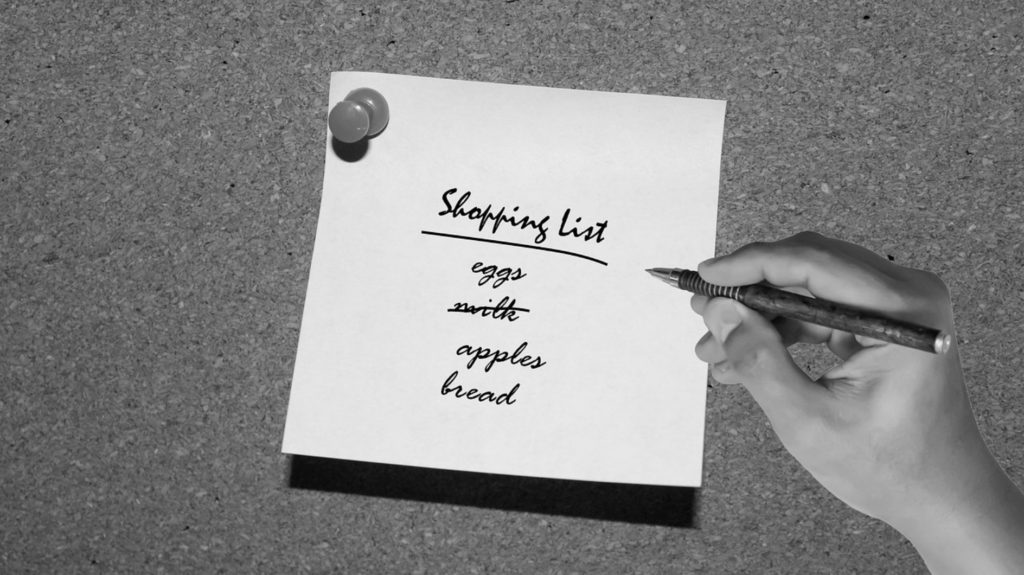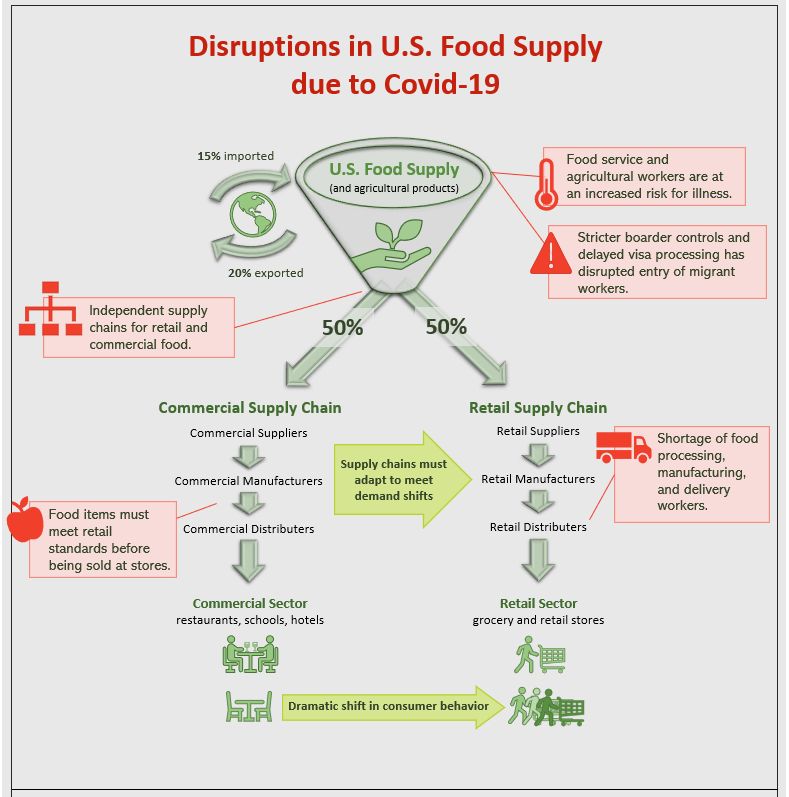 By Bruce Fenton
By Bruce Fenton
Risks of Food Shortages Resulting from Supply Chain Issues
The chaos and Nth order effects of the virus and the reaction to it have created risks in all aspects of life. Food is such a crucial need that we must examine any risks related to it. We are told that there is plenty of food, but what does that mean? US food supply, like all other aspects of our society is both complex and fragile. While we have the capability of producing enough food to feed the country, we need to also be able to deliver it and produce it in a manner that makes it usable.
Normally, about half of all U.S. food and agricultural products end up in direct to consumer markets including supermarkets, grocery and retail stores. The other half is purchased and distributed by the wholesale commercial and food service sector. This includes restaurants, schools, institutions, and the hospitality industry (including hotels, resorts, cruise ships, all primarily driven by tourism). The shut-down of many non-essential businesses, the closure of schools and universities and the issuance of stay-at-home orders and travel bans in states across the country have caused the demand for food products normally distributed through the commercial supply chain to come to a grinding halt. At the same time, the demand for food products in the grocery/retail sector has soared with some distribution warehouses running at 200% to 500% their average capacity for this time of year[1]. This extreme shift in demand and our inability to swiftly adapt our established distribution and supply chains to it is what currently poses the greatest threat to the food supply in the U.S.
We also cannot rely on imports. Increased restrictions, geopolitical tensions and the competing demands of their own shutdowns and workforce issues makes it difficult to depend on previously reliable food importers. There are also significant processing business which could be further interrupted. Surprisingly a significant amount of US seafood and other food is sent to China for processing and then sent back.
Initial bouts of flash preparedness buying have led consumers to flock to the grocery stores to buy up staples and supplies in bulk. In turn, the empty shelves have further fueled concerns of food shortages. Like the financial system, what appears sound on the surface to some has serious underlying weaknesses. Several significant, underlying short- and long-term issues related to the supply of U.S. food and agriculture products remain.
1) Independent supply chains for commercial and retail industries
The supply chains that distribute food to the commercial sector and the supply chains that supply retail/grocery sector function independently from one another and are not interchangeable under today’s system. They utilize different processors, packers, distributors, warehousing, shipping and packaging systems and procedures and are subject to different industry regulations. Because of this, it is not possible to simply redirect the food products normally channeled through the commercial sector to the retail sector.
Food products normally intended for commercial use would have to be processed, packaged, and distributed according to standards and regulations set for retail in order to be properly funneled through that channel. (Reuters) “Paul Sproule, a potato farmer in North Dakota, said processors who churn out French fries and other restaurant products have stopped buying. Most can’t pivot to retail because they don’t have customer-facing packaging or relationships with stores for shelf space.”[2] Making these sorts of changes to processing and packaging systems take time and are costly, often requiring new or modified equipment and machinery.
2) Shortage of agricultural and food service workers
In addition to the logistical challenges faced in rerouting food to retail markets, our food system is simultaneously facing increasing issues with declining numbers of agricultural and food service workers. U.S. farms depend on foreign labor and migrant workers, who filled more than a quarter-million agriculture jobs in the U.S. last year.[3] Border closures, stricter entry policies, and delays in visa processing are all impeding the entry of the workforce needed to meet seasonal harvest deadlines. U.S. based farmers and producers are already seeing the effects of these shortages as their unpicked crops begin to spoil in the fields. Georgia’s commissioner of agriculture Gary Black expressed similar concerns, “It is a reality. If there are not workers, there will be crops that will go unharvested, and that has a ripple effect throughout this economy, and it will affect the consumers of this nation”.[4] While many producers claim they would opt to fill these jobs with domestic workers, the reality is there aren’t anywhere near enough people willing to work under these jobs, under the same conditions.
See: 177 Different Ways to Generate Extra Income
We are also seeing a decline in the number of agricultural and food service workers currently employed in the U.S., due to the coronavirus pandemic. These workers are at a particularly high-risk of contracting the virus due to proximity to and close interaction with others in their work environments as well as having little to no access to healthcare. Many of these migrant workers also live together in close quarters and share transportation to and from the fields each day further increasing the likelihood of transmission.
Similarly, workforce shortages are being seen in the meatpacking industries where fewer and fewer employees are showing up each day due to fears of contracting the virus in close contact working conditions.[5] This is causing production to slow which will inevitably lead to increase waste of meat products, due to the inability to simply halt production. “There’s a concern for pork producers because they just can’t turn their buildings on or off like you can an assembly line,” he added. From the time sows give birth to slaughter, “it’s a nine-month process that started nine months ago. Pigs continue to be born every day, whether they keep the whole capacity.”[6]
What action can be taken on large-scale/industry and regulation level?
1- Eliminate regulations harming food supply and distribution. There is an immediate need for adaptations in regulation and policy to promote and accommodate necessary shifts from wholesale to retail supply chains. There needs to be an immediate elimination of all rules and regulations that govern trucking, imports, agricultural and work visas, labeling requirements for retail goods. Any rules and regulations preventing restaurants from selling groceries must be eliminated. Rules governing home based food preparation must also be eliminated or reduced. Food, safety and health officials must adapt and adjust to our changed world and the emergency we are in. The priority must be securing and increasing food supply options.
2- Adaptation by farmers, distributor, manufacturers, grocers and restaurants. Manufacturers need to find ways to adapt current systems and supply chains to re-route food supplies normally intended for commercial/wholesale distribution to the retail and grocery sector. This includes the employment of food service workers from sectors that normally serve wholesale to relieve workforce shortages in the food retail industry. Adjustments must also be made to warehousing, logistics, and purchasing processes to meet consumer facing market standards. Restaurant owners should be working hard to maintain my past food purchase levels by converting some business to groceries/ ready made grocery bags that customers can buy in bulk.
3- Safe logistics. Agricultural employers and organizations can take more proactive steps to help protect farm workers with safe standards, equipment and designing farm work to allow for distancing through shifts, physically spreading people out and other methods.
What action can be taken on a local/regional level by small businesses, local producers and farms, and consumers?
1- Smaller food retailers such as bakeries, farm markets, and cafés can help by sourcing, stocking, and offering perishable food products that have been running short at grocery stores. Many of these establishments have begun to offer more grocery products along with prepared meals and baked goods. Many small businesses are also successfully adapting by offering more delivery capabilities and by leveraging improved social media marketing and online ordering systems.
2- Small and local farms can also leverage opportunities to sell directly to consumers in their local communities. Some small farms are adapting by selling fresh produce and perishable foods in their local communities by offering no-touch deliveries and drive through pick-ups. Some local farmers are even partnering with each other to offer regular boxed deliveries that contain a variety of goods including, meats, eggs, produce, dairy products, and even baked goods all sourced from local farms and businesses. [7]
3- Restaurants should adapt to grocery sales, sales of bulk ready-made meals and should adapt to radically different pricing structures. Mid to high end restaurants should adapt to lower price bulk food. Margins will be significantly lower but if done right sales volume could increase. Some estimates say 70% of restaurants could go out of business. Survive however you can, be it deliveries, groceries or low cost bulk meal preparation.
What can consumers do?
1- Stock up on food as much as possible, buy canned goods, rice, beans, potatoes and other easy to store foods. Given the level of emergency and uncertainty we are in now 6–12 months of food for your family is reasonable. Do the math to calculate how much you need. As many have seen in recent weeks, you may eat more than you realize, especially with a family. If you are financially able, getting even more food is worthwhile. If you don’t use it you can always sell or give away or donate it. Unfortunately, the jobs and financial crisis will likely increase demand for food among the needy for a year or more.
2- Support the same local restaurants they normally would by ordering takeout when possible. Many communities are compiling lists of local businesses that are still open for takeout. These businesses have been some of the most effected by the shift in demand and by ordering takeout consumers can help provide some income to the restaurants, while also encouraging food resources to flow through the existing commercial supply chains.
3- Buy local, and when possible, directly from farmers, fishers etc. who are no longer able to sell to restaurant and local and regional farmers markets. Check to see if your local community has Facebook pages and/or groups which are helping to spread the word about what local food products are available from local farms and fishermen in your area. Because of how quickly local producers have had to adapt, many do not yet have online ordering systems and up to date websites, but many have set up social media pages where they are able to easily reach a large local audience, post daily what they have available, and even coordinate orders.[8]
Notes:
[1] https://www.npr.org/2020/03/18/817920400/empty-grocery-shelves-are-alarming-but-theyre-not-permanent
[2] https://www.reuters.com/article/us-health-coronavirus-dairy-insight/u-s-dairy-farmers-dump-milk-as-pandemic-upends-food-markets-idUSKBN21L1DW
[3] https://www.cbsnews.com/news/coronavirus-us-farmers-foreign-labor-crops-unharvested/
[4] https://www.cbsnews.com/news/coronavirus-us-farmers-foreign-labor-crops-unharvested/
[5] https://www.politico.com/news/2020/04/05/food-waste-coronavirus-pandemic-164557
[6] https://www.politico.com/news/2020/04/05/food-waste-coronavirus-pandemic-164557
[7] https://www.washingtonpost.com/news/voraciously/wp/2020/04/01/facing-devastating-losses-small-farmers-pivot-to-sell-directly-to-consumers/
[8] https://www.usnews.com/news/best-states/articles/2020-04-09/new-hampshire-lobster-boats-stay-afloat-with-direct-sales?fbclid=IwAR2R-eOV8orAcut4qMozU-ft0rXGYJw1YGubqhzm3eWjFqtTXLls6jhCm1I
Source: Medium
Bruce Fenton — CEO, Chainstone Labs Founder, Atlantic Financial, Satoshi Roundtable, #Bitcoin, securities. Owner of Watchdog Capital, a US broker dealer. New Hampshire farmer.
Top image: Pixabay
Subscribe to Activist Post for truth, peace, and freedom news. Become an Activist Post Patron for as little as $1 per month at Patreon. Follow us on SoMee, Flote, Minds, Twitter, and HIVE.
Provide, Protect and Profit from what’s coming! Get a free issue of Counter Markets today.


Be the first to comment on "Where Will The Food Come From?"